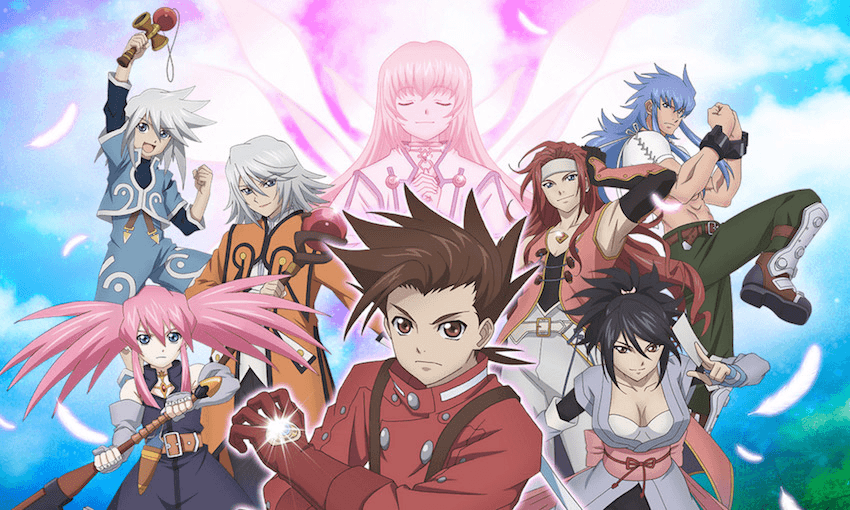The JRPG has been in decline for the past decade, but the Tales series continues to attract a dedicated audience. Sam Brooks investigates how it has survived so long.
The first Tales game I ever played was a good ten years after its debut. It was 2005, the year where we pre-emptively gave Reese Witherspoon an Oscar for playing June Carter, and I had been looking for an RPG to spend my weekends on (oh to be a teenager with a seemingly unlimited amount of things to do). My friend excitedly let me borrow Tales of Symphonia – the only game in the series to be released on GameCube, and the first to ever come out in Europe. (If you’re a fifth generation console kid, you will remember the vagaries of regions meant that sometimes games would just skip coming out in Europe, and these were often RPGs with small fanbases.)
I’d never heard of the Tales series before, because the internet barely existed in New Zealand back in 2005, and so I dived into this game with no idea what to expect. I found a surprisingly deep – and surprisingly dark – RPG that consciously subverted the anime style from which it got its visual style. And it was a honest-to-god RPG, with no open world stuff, no constantly refillable generic side quests and no endless hunts. It was a game you could spend fifty hours in and not even touch the sides.
In the twelve years since I played Tales of Symphonia, the series has changed very little and has made few upgrades or changes to the formula. It remains a series that draws heavily from anime (maybe moreso than any series other than Persona, one of the only other JRPGs to survive unscathed in the past decade) and one that continues to split the difference between beat-’em-up and turn-based gameplay. In fact, the only thing that has changed is its relative prominence.
Since Tales of Symphonia, which is still arguably the most famous and most acclaimed RPG of the entire series, Tales has garnered solid – often great – reviews while staying commercially successful enough to routinely guarantee English releases as well. Each title since Tales of Graces has been translated into English with a top-tier voice cast; it’s often ported across multiple systems -–PS3, PS4, Windows and Xbox – and it continues to be reviewed well in an environment that stands in opposition to almost everything Tales represents.
Which is what, exactly?
Oh, I’ll tell you!
The most distinctive thing about the Tales series is its style. As games step closer and closer to photorealism, the Tales series has doubled down on being the closest thing to a playable anime as we can get, complete with anime opening sequences and cutscenes.
There’s a tendency for ‘anime’ to be used as a pejorative – if you describe something as anime then you’re comparing it to the worst of the genre. (Your Narutos, your One Pieces, so on and so forth.) But what the Tales series actually nails – especially in the run of Abyss, Grace and Xillia – is anime’s way to emotionally engage and involve an audience in the content with near unparallelled immediacy.
Anime, moreso than any other medium I’ve encountered, sits comfortably in a structure and series of tropes. Characters are expressed visually and aurally as much as they’re expressed through what they say. Take Lloyd from Tales of Symphonia. Everything about him codes him as the protagonist. Big brown eyes? Check. Spiky hair? Check. Bright reds with muted black? Check. Even his weapons – two blades, so pretty standard but with a twist – code him as our protagonist. There’s an immediacy to it that an anime-literate audience clicks into.
Countless games play on anime tropes – Xenos, Stars Oceans, Legends of Heroes – but where the Tales series finds its point of difference, and truly hooks into its niche, is the way in which it subtly twists and turns its tropes, its plots and its characters on their heads. While the art style of the Tales series is bright as hell, and more resembles shonen anime than anything, these games make effective if sometimes clumsy stabs at thematic depth.
Take Tales of the Abyss, one of the more popular entries in the series, which makes a good attempt at exploring what it means to be a human, and what it means to claim your own identity. The protagonist, Luke, is quickly revealed to be a clone of somebody else – and spends the rest of the game questioning his own sense of reality as a result. Abyss delves into this with a surprising amount of realism, and the dialogue is authentic and beautifully translated, especially for a genre that so rarely reaches either of these benchmarks.
Other games in the series tackle racism, religion and faith – albeit not with the depth or intellectual clarity that you might hope for, but when a game looks as cheery and is as immediately bright and involving as Tales, it can be surprising that you’re feeling and thinking along with the fun.
Where other games expanded and seemed to drown trying to keep pace with the rest of the industry – the Final Fantasy series is a sad example of this – the Tales series has kept quietly honing what it does best: anime stories with a twist, and with more depth than you’d expect. It’s also managed to actually stay fun.
This post, like all our gaming content, comes to your peepers only with the support of Bigpipe Broadband.
